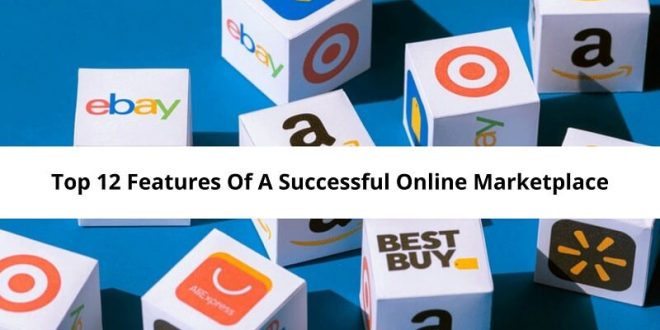In this article, I am going to talk about the top 12 features of a successful online marketplace. So keep reading.
With the turn of the millennium, the world has seen drastic changes. Thanks to the internet, marketers and consumers that were once out of reach are today just a click away. As the markets grew exponentially and the world grew smaller, online marketplaces became popular business models and a necessity.
An online marketplace is simply an e-platform that musters buyers and sellers to bring them together in one commonplace. This digital consumer market is the perfect tool for companies and businesses to reach customers and gain new ones who want to purchase their products and services.
Over the past decade, the number of marketplaces has exploded because of consumers’ real convenience. This convenience has resulted in online marketplaces because customers can now access a suppliers’ inventory digitally from any part of the world.
The best part is that these marketplaces don’t have to own any inventory. All the products and services sold by suppliers are directly available to the users, with real-time information about the same being readily available to them on an online site, app, or platform.
Features Of A Successful Online Marketplace
Not just this, consumers now have access to a much broader assortment of options of products and services than what they would find in any store, shop, or showroom. It’s a simple fact; we’re always looking for more choices and options; that’s the main reason consumers don’t like using apps of one single retailer or brand.
This results in shoppers often downloading an app or visiting an e-shopping site that offers product ranges that are extensive and broader than what one store could offer.
The main thing to keep in mind to have a successful marketplace is an organized supply and a robust demand since both users of the platform need to find the value out of using your platform.
A good marketplace allows for the two to interact by basically making it easy for the suppliers to provide a service or product which the Demanders or consumers need and facilitates that process efficiently.
Now that you understand an online marketplace let’s see the qualities of a good e-commerce website.
In this segment, we would explore the top 12 features of a successful online marketplace and some tips and tricks to help you build one.
1.Take Web Security Seriously
Be it the big players like eBay or start-up marketplaces, you’ll find that web security is their top priority, and it should be the same for you too! Why? That’s because e-commerce sites will always be a hot target for hackers and cyber attackers.
For these digital thugs, online marketplaces are like treasure troves of personal, confidential, and financial information. No matter how big or small the business is, the cost of a breach results in a huge loss of data and customer trust.
Online business owners are constantly adding increasingly innovative technologies to their platform to stay safe and secure from cyber attackers and hackers who, in their part, are equally coming up with new techniques and tricks to exploit loopholes if they find any.
The security of your users’ data should be paramount, and that’s the reason you should start with investing in SSL authentications. SSL certificate or secure socket layer provides a safe and reliable transfer layer that protects your and your user’s confidential and precious data from falling into the wrong hands.
SSL certificates work alongside the HTTP protocol to give a more secure form, the ‘HTTPS’ protocol. Having an SSL certificate ensures that any communication between the server and browser stays encrypted and safe. SSL protects your site’s sensitive data like credit information, debit card details, bank credentials, usernames, and passwords from hackers and cybercriminals.
But merely investing in an SSL certificate is not enough; to make hacking more difficult and challenging, you should constantly update security protocols. By doing so, you’re reducing the risk of online fraud and safeguarding your business transactions.
The bottom line is that SSL not only establishes a secure connection but also assures the customers that their transactions on your site are secure, which builds their trust in your platform. If you are on the lookout for SSL certificates at cheap prices then you can consider buying SSL certificates from ClickSSL as they are offering huge discounts on SSL Certificates.
2. Make Signing Up As Easy As Possible
Today’s market is fast-paced and is looking for an easy and convenient sign-up process. As an online marketplace owner, it’s important to understand that their time is precious. They do not have the energy to type in their complete email address, name, or other basic information to gain access to your website.
It has been found that users access numerous apps and sites on different devices where it is not always convenient for them to type in tiny and non-important details while logging in. You have to remember that this process of signing up is not just about the users; it’s about your business as well.
As an e-commerce site owner, it’s your responsibility to engage your users, but at the same time, you also have to keep in mind to get the business value from it.
Having a long and time-staking sign-up process would damage the user experience, and people will probably avoid your platform. The question now arises, how should your sign-up process be?
Well, there’s no simple answer to this, but it depends on your strategy. If you ask for the sign-up without telling your users about the benefits could be a big mistake as they would find the whole process mundane and unnecessary.
People would like to know what they stand to benefit from signing up. Will they get some offers? Will they be notified about the product or service? If there isn’t any gratification, they will not sign up.
Try to capitalize on the process rather than keep it just a boring process of filling an endlessly long form. Also, keep in mind that the sign-up should have minimal steps and be user-friendly. This way, customers wouldn’t mind spending a few extra minutes signing up.
3. Simplify On-Boarding
This is an extension of the sign-up process. Onboarding means getting your consumers onboard your site or app with minimal steps and as efficiently as possible. The fact of the matter is that none of us likes to fill out lengthy forms and documentation to sign-up on an online marketplace; after all, we’re on the site to shop.
Are you asked to fill out forms when you go to a store? You also have to be mindful that not everyone is willing to give out too much of their personal information in the process.
Keep user experience in mind and make sure the entire journey from sign-up to check out should be simple, uncomplicated, and straightforward.
4. Have A Streamlined And Advanced Search Functionality
There are instances when a user cannot find what they’re looking for even though you have it on your site or app. This can be very frustrating for the customer.
If you’re an online marketplace owner with a platform with an abundance of products and services to offer, advanced search is a very important tool. You cannot expect your customers to skim through all of the listings in a short period.
They should be able to search for the desired product or service by applying filters that would categorize exactly what they’re looking for, making it easier for them.
Additionally, it’s also a good idea to integrate Google maps so that it becomes easier for the customer to know if the product can be delivered to their location or if the product or service is available in their area or not.
5. Incorporate Instant Messaging And Notifications
Communicating with your user is crucial, and you must keep this point in mind when developing your platform. Don’t let your users feel alone and helpless. Online shopping could be a confusing affair, especially for first-time users.
There are frequent instances of customers not finding what they’re looking for even though you have the inventory or in cases where your customers might have some query about a certain product and its price. At times like these, they usually feel lost and eventually end up leaving your website.
Having notifications that inform your users about offers, price drops, or simply recent updates in their account can be a boon and quite helpful to them.
6. Be Language And Currency Friendly
The internet is vast, and so is your market, but you have to be mindful that your customers might not be geographically bound or defined. The web has brought everyone closer, but there are still language and communication barriers. As an online business owner, you should be careful not to lose yourself in translation or rather the lack of it.
Try and have your product or service descriptions in multiple languages. By doing so, you’re making them feel much more comfortable when they’re visiting your site or platform and indirectly boosting the user experience.
The other point to keep in mind is the currency. As mentioned above, your customers are not from a fixed geographic location. They’re spread across the world in different countries with different currencies.
Your job as an e-commerce business owner should be to make transitions easy for them. The demand is there; all you have to do is make it convenient for them. Work out exchange rates and partner with exchanges that give you and your users the best rates and benefits.
7. Rewarding Loyalty
The fact is, loyalty pays because loyal customers who frequently buy from you are way more profitable than the customers that only buy once. The reason behind this logic is that repeat customers have a higher long-term value, which means that throughout a regular and frequent customer’s projected buying frequency with your brand, you would be able to predict a high return on investment.
Even though customers become loyal to a brand when they find that products are of high quality and get good customer service, they can gain their trust by offering some gratifications. Loyalty programs and rewards do just that!
A loyalty program helps push customer faith in your brand by providing rewards to them from their frequent patronage towards your business’ products and services. A loyalty program can include rewards on referrals, free merchandise, coupons, access to unreleased products, discounts, and rebates.
In a way, loyalty programs guide their decision-making to choose your brand over the competition.
8. Ramp Up The Buyer’s Page
You might’ve heard the saying that the customer is the king. The same applies to your online marketplace and to ensure that your users feel like a king, your page’s user interface and experience must be premier.
As an online marketplace owner, your emphasis should be on making every user’s buying experience unique, easy, and enjoyable. You can even personalize pages of every product segment to improve user engagement or have suggestions based on their search history.
The more features you offer on your page to your customers, the lower the chances of abandoning your site.
9. Have A Safe And Reliable Payment Gateway
As an eCommerce site, most of your trades and payments would be in digital or e-payment form. But even though online transactions are fast, they are however vulnerable to hacking, and that’s something that could be potentially disastrous for your business.
After all, it’s not just your data that’s at risk. It’s your users’ financial and confidential information as well. Have proper and multiple payment gateways like bank transfer, Stripe, PayPal, PayMill, Telr Payment, Braintree, GoCardless, etc., which are secure and convenient.
Additionally, instead of storing your customer’s payment credentials, it’s advisable to use a third-party payment portal to handle the final transactions. This not only ensures the safety of your customer’s data but also reduces your liability in case your website does come under attack.
10. Make Your Site Flexible And Mobile-Friendly
Gone are the days when people would access the web through their desktop or PC. Today, anyone can log on to the web with not just a click but a tap of their finger. Everything they need is in the palm of their hand.
Therefore, it’s important that your site be cross-platform and not just accessible through a web browser. Focus on developing a mobile-responsive website for your marketplace. This would also ensure that the site visitors will choose you over the competition if you have a mobile app.
You must have a responsive website that can adapt well to desktop and mobile, tablets, and other platforms.
11. Reviews, Ratings, And Testimonials Are Your Secret Weapons
Numbers speak louder than words, and statistics show that many online shoppers and consumers prefer to go through reviews to determine what products or services to purchase.
It’s been proven that simply informing users of the availability of a product or service on your site is just not enough; customers also want to know and learn from the first-hand experiences of other shoppers.
Online businesses and e-commerce sites that don’t have any ratings or reviews don’t just miss out on an opportunity to grow their business. Still, it seems less credible and reliable to the shoppers. Therefore, you should give ratings, testimonials, and reviews priority as well.
12. Use Social Media To Your Advantage
Unlike conventional and digital advertising or other marketing assets, social media sharing is an organic form of promotion paid or generated by the brand. Still, it is created and promoted by your audience and users.
It works by consumers sharing your products, blog posts, reviews, testimonials, and content because they were satisfied and gratified. It creates online engagement about your business and increases your business’s online presence.
Be it a simple tweet, Facebook share button, Snapchat’s stories, or Instagram posts, all of these social activities create a buzz for your brand.
To Conclude
While we’ve just brushed only some of the core features of a successful online marketplace, there are, however, some e-commerce platforms that disrupt the industry with their engagement and uniqueness.
We advise you to do your research and learn from their journey while keeping in mind the tips shared above.
Online marketplaces cater to the buyers and the sellers by offering a wide range of benefits to both parties. On the one hand, sellers can reduce their marketing and selling costs to boost their sales, while buyers can explore and compare products and services safely and securely through your site.
 free html design Free html design templates
free html design Free html design templates






